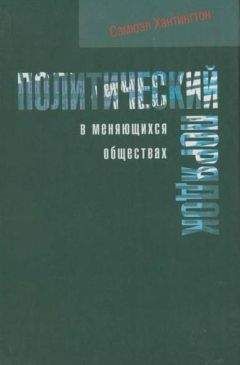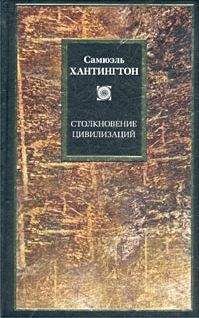Сэмюэл Хантингтон - Политический порядок в меняющихся обществах

Помощь проекту
Политический порядок в меняющихся обществах читать книгу онлайн
5. Революция и политический порядок
(1) Carl J. Friedrich, Man and His Government (New York, McGraw-Hill, 1963), p. 644.
(2) Hanna Arendt, On Revolution (New York, Viking, 1963), p. 28.
(3) Стефен Маршалл, 1641, цит. в кн.: Michael Waltzer, The Revolution of the Saints (Cambridge, Harvard University Press, 1965), p. XIV. В исследовании Уолцера убедительно показана модернизаторская, революционная природа пуританства.
(4) George S. Pettee, The Process of Revolution (New York, Harper, 1938), p. 96.
(5) Ibid., p. 100–101.
(6) Crane Brinton, The Anatomy of Revolution (New York, Vintage, 1958).
(7) Leon Trotsky, My Life (New York, Scribner's, 1930), p. 337; цит. в кн.: Merle Fainsod, How Russia is Ruled (Cambridge, Harvard University Press, 1953), p. 84. — Es schwindelt — это головокружительно (нем.)
(8) Ср. Chalmers Johnson, Revolution and the Social System (Stanford, Hoover Institution, 1964), p. 3–22; Harry Eckstein, «Internal War: The Problem of Anticipation», in Ithiel de Sola Pool et al., Social Science Research and National Security (Washington, Smithsonian Institution, 1963), p. 116–118.
(9) Pettee, p. 12, 100; Brinton, p. 100 ff.; Johnson, p. 5 ff.
(10) R.R.Palmer, The Age of the Democratic Revolution, 1,484.
(11) Barbara Ward, «The City May Be as Lethal as the Bomb», New York Times Magazine, April 19,1964, p. 22.
(12) Ernest Halperin, «The Decline of Communism in Latin America», Atlantic Monthly, 215 (May 1965), 65.
(13) Glaucio A.D. Soares, «The Political Sociology of Uneven Development in Brazil», in Irving L. Horovitz, ed., Revolution in Brazil (New York, Dutton, 1964), p. 191; Andrew Pearse, «Some Characteristics of Urbanization in the City of Rio de Janeiro», in Philip Hauser, ed., Urbanization in Latin America (Paris, UNESCO, 1961), p. 196.
(14) Angus Campbell et al., The American Voter (New York, John Wiley, 1960), p. 209–210; Frank Bonilta, «Rio's Favelas», American Universities Field Stuff Report Service (East Coast South American Series, Vol. 8, No. 3, February 1,1961), 12; John P. Harrison, «The Role of the Intellectual in Fomenting Change: the University», in John TePaske and Sydney N. Fisher, eds., Explosive Forces in Latin America (Columbia, Ohio State University Press, 1964), p. 34; Daniel Goldrich, «Toward an Estimate of the Probability of Social Revolutions in Latin America: Some Orienting Concepts and a Case Study», Centennial Review, 6 (Summer 1962), 400. См. также: Daniel Goldrich, Raymond B. Pratt, and C.R. Schuller, «The Political Integration of Lower Class Urban Settlements in Chile and Peru: A Provisional Inquiry» (доклад на ежегодной встрече Американской политологической ассоциации, Нью-Йорк, 5-10 сентября 1966 г.).
(15) Halperin, р. 66.
(16) H. Rotondo, «Psychological and Mental Health Problems of Urbanization Based on Case Studies in Peru», in Hauser, p. 255.
(17) Soares, p. 191–192; Alfred Stepan, «Political Development Theory: The Latin American Experience», Journal of International Affairs, 20 (1966), p. 229–231; Joseph A. Kahl, «Social Stratification and Values in Metropolis and Provinces: Brazil and Mexico», America Latina, 8 (Jan. — Mar. 1965), 33. Cf. John C. Leggett, «Uprootedness and Working-Class Consciousness», American Journal of Sociology, 68 (1963), 682 ff.
(18) Weiner, The Politics of Scarcity, p. 205–206, и Weiner, «Urbanization and Political Protest», Civilisations, 17 (1967), p. 44–50.
(19) Oscar Handlin, The Uprooted (Boston, Little Brown, 1951), p. 267; Will Herberg, Protestant-Catholic-Jew (Garden City, N.Y., Doubleday, 1956), p. 28–35; Marcus L. Hansen, The Immigrant in American History (Cambridge, Harvard University Press, 1940), p. 92–96.
(20) Claude Brown, Testimony, Hearings on Federal Role in Urban Problems, U.S. Senate, Subcommittee on Executive Reorganization of the Committee on Government Operations, 89th Congress, 2d Session (1966), Part V, p. 1106; Philip Meyer, A Survey of Attitudes of Detroit Negroes After the Riot of 1967 (Detroit, Detroit Urban League and Detroit Free Press, 1967).
(21) Kornhauser, The Politics of Mass Society, p. 150–151; курсив в оригинале.
(22) См. George Е. Lichtblau, «The Politics of Trade Union Leadership in Southern Asia», World Politics, 7 (1954), p. 89–99; Arnold Zack, Labor Training in Developing Countries (New York, Praeger, 1964), p. 12; Bruce Millen, The Political Role of Labor in Developing Countries, p. 49–52; Robert J. Alexander, Organized Labor in Latin America (New York, Free Press, 1965), p. 13; Marshall R. Singer, The Emerging Elite (Cambridge, M.I.T. Press, 1964), p. 128–136.
(23) Gaston V. Rimlinger, «The Legitimation of Protest: A Comparative Study in Labor History», Comparative Studies in Society and History, 2 (April 1960), p. 342–343.
(24) Henry A. Landsberger, «The Labor Elite: Is It Revolutionary?» in Seymour Martin Lipset and Aldo Solari, eds., Elites in Latin America (New York, Oxford University Press, 1967), p. 260.
(25) Lichtblau, p. 100.
(26) Lloyd Fallers, «Equality, Modernity, and Democracy in the New States», in Clifford Geertz, ed., Old Societies and New States (New York, The Free Press, 1963), p. 188. См. также замечание Теодора Дрейпера, что кубинские профсоюзы «сумели за многие годы добиться немалого числа уступок и привилегий, что превратило членов этих профсоюзов в сравнительно привилегированный класс». Castroism: Theory and Practice (New York, Praeger, 1965), p. 76–77.
(27) Landsberger, p. 271.
(28) Halpern, The Politics of Social Change in the Middle East and North Africa, p. 75; Draper, p. 79.
(29) Bert F. Hoselitz and Myron Weiner, «Economic Development and Political Stability in India», Dissent, 8 (Spring 1961), 177; Benjamin B. Ringer and David L. Sills, «Political Extremists in Iran», Public Opinion Quarterly, 16 (1952–1953), p. 693–694.
(30) Palmer, /, p. 483–484.
(31) John Maynard, The Russian Peasant and Other Studies (London, Victor Gollancz, 1947), p. 74–75; Launcelot Owen, The Russian Peasant Movement, 1906–1917 (New York, Russell and Russell, 1963), p. 139. Мне также оказались очень полезными сведения по этим вопросам, содержащиеся в неопубликованной работе: JoClayre Marvin, «The Political Role of the Russian Peasantry, 1890–1921» (Cambridge, Mass., Harvard University, 1965).
(32) Owen, p. 138; Ленин процитирован в кн.: William Henry Chamberlin, The Russian Revolution, 1917–1921 (New York, Macmillan, 1952), /, 294.
(33) Mao Tse-Tung, «Report of an Investigation into the Peasant Movement in Hunan»; перепечатка в кн.: Stuart R. Schram, ed., The Political Thought of Mao Tse-Tung (New York, Praeger, 1963), p. 180–182,184; курсив в оригинале.
(34) Celso Furtado, цит. в работе: Thomas F. Carrroll, «Land Reform as an Explosive Force in Latin America», in TePaske and Fisher, p. 119–120.
(35) Paul Stirling, «Structural Changes in Middle East Society», in Philip W. Thayer, ed., Tensions in the Middle East (Baltimore, Johns Hopkins Press, 1958), p. 145. См. также работу: Douglas D. Crary, «The Villager», in S.N.Fisher, ed., Social Forces in the Middle East (Ithaca, Cornell University Press, 1955), p. 52. По этому вопросу мне была также полезна неопубликованная работа Стивена Дейла: «The Anatomy of La Miseria: A Critique of Banfield's Theory of the Moral Nature of Underdeveloped Societies» (Cambridge, Mass., Harvard University, 1966).
(36) Celso Furtado; цит. в работе: Carroll, «Land Reform», p. 120; см. также: Royal Institute of International Affairs, Agrarian Reform in Latin America (London, Oxford University Press, 1962), p. 15.
(37) Полезное обсуждение перспектив союза между университетскими интеллектуалами и городской беднотой см. в работе Харрисона «University», in TePaske and Fisher, p. 34–36.
(38) См.: Edmundo Flores, Land Reform and the Alliance for Progress (Princeton, Center of International Studies, 1963), p. 13.
(39) О Мексике см. в кн.: Henry Bamford Parker, A History of Mexico (rev. ed. Boston, Houghton Mifflin, 1950), p. 309. О Кубе см. в работе: Leland L. Johnson, «U.S. Business Interests in Cuba and the Rise of Castro», World Politics, 17 (April 1965), p. 440–459.
(40) Palmer, 2, 4.
(41) См.: Perlmutter, «Ambition and Attrition», Chap. 3, p. 10, 11; Chalmers Johnson, Peasant Nationalism and Communist Power (Stanford, Stanford University Press, 1962), p. 22–26; Richard Cottam, Nationalism in Iran (Pittsburg, University of Pittsburgh Press, 1964), p. 291.
(42) Leon Trotsky, History of the Russian Revolution (New York, Simon and Schuster, 1932), p. 2, 46.
(43) Edwin Reingold, Time, 84 (August 14, 1964), 28.
(44) Цит.: С.К.Макклэтчи (Washington Post, September 26,1965, p. E4).
(45) См. блестящее истолкование этого феномена у Уолцера в кн.: Waltzer, Revolution of the Saints, passim.
(46) Bertran de Jouvenel, On Power (Boston, Beacon Press, 1962), p. 218.
(47) Ibid.
(48) См.: Howard F. Cline, The United States and Mexico (2nd ed. Cambridge, Harvard University Press, 1965), p. 52; Parkes, p. 308.
(49) Robert E. Scott, Mexican Government in Transition (Urbana, University of Illinois Press, 1959), p. 96.
(50) См.: Kalman Silvert, ed., Expectant Peoples (New York, Random House, 1963), p. 358–361.
(51) Edwin Lieuwen, Arms and Politics in Latin America, p. 101.
(52) Ласаро Карденас; цит. в кн.: Lieuwen, p. 114. См. выше, с. 256–257, о росте цивилизованности мексиканского политического руководства.
(53) О Карденасе см. у Скотта, с. 127.
(54) Gabriel A. Almond and Sidney Verba, The Civic Culture.
(55) Sidney Verba and Gabriel A. Almond, «National Revolutions and Political Commitment», in Harry Eckstein, ed., Internal War (New York, The Free Press, 1964), p. 230; Almond and Verba, Civic Culture, p. 99, 219. Cp. Robert E. Scott, «Mexico: The Established Revolution», in Pye and Verba, eds., Political Culture and Political Development, p. 330–395.
(56) Russell et al., World Handbook of Political and Social Indicators, p. 239; Cornelius H. Zontag, The Bolivian Economy, 1952–1965 (New York, Praeger, 1966), p. 144.
(57) Richard Patch, «Bolivia: The Restrained Revolution», Annals, 334 (March 1961), p. 127.
(58) De Jouvenel, p. 219.
(59) О формах организации рабочих в Мексике и Боливии см. в кн.: Alexander, Organized Labor in Latin America, p. 102–110,197-198.
(60) Richard W. Patch, «Bolivia: U.S. Assistance in a Revolutionary Setting», in Richard Adams, ed., Social Change in Latin America Today (New York, Vintage, 1960), p. 119–124.
(61) Richard Weinert, «Bolivia's Shaky Truce», The New Leader, 48 (July 5,1965), p. 8.
(62) The Daily Journal (Caracas), June 4,1965, p. 24.
(63) Roy R. Rubottom, Jr., Assistant Secretary of State for Inter-American Affairs, Hearings on Mutual Security Act of 1960, U.S. House of Representatives, Committee on Foreign Affairs, 86th Cong., 2nd Sess. (1960), p. 847; цит. в: Patch, «U.S. Assistance», p. 159. Я и вообще опирался на Пэтча в отношении влияния американских программ помощи в Боливии.
(64) Patch, «U.S. Assistance», p. 133.
(65) Paz Estenssoro, New York Times, Oct. 26,1963, p. 9.
(66) В.И. Ленин. Что делать? // ПСС, т. 6. С. 117.
(67) Там же. С. 69.
(68) Там же. С. 112.
(69) Benjamin Schwartz, Chinese Communism and the Rise of Mao (Cambridge, Harvard University Press, 1951), p. 193, 198.
(70) В.И. Ленин. Что делать? // ПСС, т. 6. С. 122–127.
(71) Лев Троцкий, цит. по: Fainsod, р. 139.
(72) Ленин. Что делать? См. также блестящую интерпретацию Ленина как пионера в разработке возникшей в XX в. теории организации в кн.: Sheldon Wolin, Politics and Vision (Boston, Little Brown, 1960), p. 421–429.

























